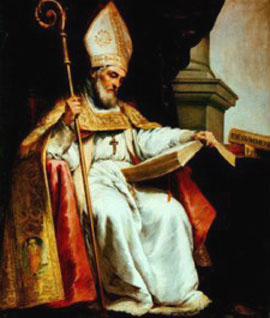| Isidore of Seville  Born: c. 560 AD Born: c. 560 AD
Birthplace: Cartagena, Spain
Died: 4-Apr-636 AD
Location of death: Seville, Spain
Cause of death: unspecified
Gender: Male
Religion: Roman Catholic
Race or Ethnicity: White
Occupation: Encyclopaedist Nationality: Spain
Executive summary: Originum sive Etymologiarum Isidore of Seville, or Isidorus Hispalensis, Spanish encyclopaedist and historian, was the son of Severianus, a distinguished native of Cartagena, who came to Seville about the time of the birth of Isidore. Leander, bishop of Seville, was his elder brother. Left an orphan while still young, Isidore was educated in a monastery, and soon distinguished himself in controversies with the Arians. In 599, on the death of his brother, he was chosen archbishop of Seville, and acquired high renown by his successful administration of the episcopal office, as well as by his numerous theological, historical and scientific works. He founded a school at Seville, and taught in it himself. In the provincial and national councils he played an important part, notably at Toledo in 610, at Seville in 619 and in 633 at Toledo, which profoundly modified the organization of the church in Spain. His great work, however, was in another line. Profoundly versed in the Latin as well as in the Christian literature, his indefatigable intellectual curiosity led him to condense and reproduce in encyclopaedic form the fruit of his wide reading. His works, which include all topics -- science, canon law, history, or theology -- are unsystematic and largely uncritical, merely reproducing at second hand the substance of such sources as were available. Yet in their inadequate way they served to keep alive throughout the dark ages some little knowledge of the antique culture and learning. The most elaborate of his writings is the Originum sive etymologiarum libri XX. It was the last of his works, written between 622 and 633, and was corrected by his friend and disciple Braulion. It is an encyclopaedia of all the sciences, under the form of an explanation of the terms proper to each of them. It was one of the capital books of the middle ages.
On the Libri differentiarum sive de proprietate sermonum -- of which the first book is a collection of synonyms, and the second of explanations of metaphysical and religious ideas. Mommsen has edited the Chronica majora or Chronicon de sex aetatibus (from the creation to AD 615) and the "Historia Gothorum, Wandalorum, Sueborum", in the Monumenta Germaniae historica, auctores antiquissimi; Chronica minora II. The history of the Goths is a historical source of the first order. The De scriptoribus ecclesiasticis or better De viris illustribus, was a continuation of the work of St. Jerome and of Gennadius. Especially interesting is the De natura rerum ad Sisebutum regem, a treatise on astronomy and meteorology, which contained the sum of physical philosophy during the early middle ages. The Regula monachorum of Isidore was adopted by many of the monasteries in Spain during the 7th and 8th centuries. The collection of canons known as the Isidoriana or Hispalensis is not by him, and the following, attributed to him, are of doubtful authenticity: De ortu ac obitu patrum qui in Scriptura laudibus efferuntur; Allegoriae scripturae sacrae et liber numerorum; De ordine creaturarum.
Father: Severianus
Brother: Leander (Bishop of Seville, d. 599)
Canonization 1598
Do you know something we don't?
Submit a correction or make a comment about this profile
Copyright ©2019 Soylent Communications
|